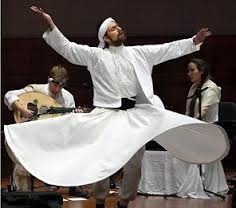Video - Sacred Dance
Since the beginning of time, we have celebrated Spirit and
how Spirit moves us through Sacred dance. Here are a few examples. I hope you enjoy them.
how Spirit moves us through Sacred dance. Here are a few examples. I hope you enjoy them.
|
A Spiritual Offering: Whirling Dervishes of the Istanbul Historical Turkish Music Community 1 (HQ) |
|
|
Turkey's Whirling Dervishes
Published on Aug 14, 2013 Dating from the thirteenth century, the Sema ritual performed by the Semezens from the Mevlevi Order of Whirling Dervishes is a UNESCO Masterpiece of the Oral and Intangible Heritage of Humanity. |
|
|
Dance of a thousand hands |
|
|
This Is The Best Art Performance From China ( Thousand-hand ~ Guan Yin ~ 千手观音 ) |
|
|
Sheila Rabbitt and Dancers perform a modern dance choreographed to the Loreena McKennitt song "The Mystic's Dream" from her album "The Mask and the Mirror". This modern dance is based on the book "The Mists of Avalon" by the late Marion Zimmer Bradley. The book is a retelling of the myth and story of King Arthur as told through the eyes of the women: Guinevere, Morgaine, Viviane and Igraine. In the book, Avalon is where the priestesses live and future priestesses are trained in worshipping "The Goddess". This dance work originally premiered at the Saint Louis Dance Festival in May of 2004 at the Edison Theatre at Washington University in Saint Louis.
|
|
|
Mummers Plays (also known as mummering) are seasonal folk plays performed by troupes of actors known as mummers or guisers (or by local names such as rhymers, pace-eggers, soulers, tipteerers, galoshins, guysers, and so on), originally from the British Isles (see wrenboys), but later in other parts of the world. They are sometimes performed in the street but more usually as house-to-house visits and in public houses. Although the term mummers has been used since medieval times, no play scripts or performance details survive from that era, and the term may have been used loosely to describe performers of several different kinds. Mumming may have precedents in German and French carnival customs, with rare but close parallels also in late medieval England
|
|
|
An Amazing sharing of Interfaith Sacred Dance to Loreena Mckennitt 's Marco Polo |
|
|
The Findhorn Sacred Dance group performing Healing and Wholeness during the community's 50th birthday celebrations.
|
|
|
Hindu Temple Dancing Invocatory items in bharatanatyam - Priyadarshini govind - classical Indian hindu temple dance Bharathanatyam bharatnatyam Bharatanatyam Bharata natyam |
|
|
Savitha Sastry Bharatanatyam Performance |
|
|
Australian Aboriginal Sacred Dance 1 |
|
|
American Indian Dances at Indian City USA. Circa 1950s |
|
|
San Marcos' sacred springs reawaken when over one hundred Native American powwow dancers and participants arrive for the much anticipated 1st Annual Sacred Springs Powwow & Indian Market, held on Saturday, May 1, 2010, from 10:00 AM until 7:00 PM at Aquarena Center, 921 Aquarena Springs Drive, San Marcos, Texas. ; The event is sponsored by a local Native American nonprofit organization, Indigenous Cultures Institute, with support from Hays County, the City of San Marcos, San Marcos Arts Commission, Texas State University, and CenturyLink."The Sacred Springs area is one of the oldest inhabited sites in North America and Native people believe it's one of three creation sites where we originated," says Dr. Mario Garza, board chair of the institute.
|
|
|
Loon Lake Powwow '09, Mens Traditional Special, Part 1 |
|
|
Sidi Goma is a group of African Indian Sidis from the Bharuch district of Gujarat. This tribal Sufi community of East African origin came to India eight centuries ago, and preserved and carried on the tradition of Sidi music and dance adapted from African rituals (which includes a dance known as goma). They carried with them their exceptionally rich musical tradition and kept it alive and flourishing through the generations, unknown to the rest of the world.
A traditional occupation of African-Indian Sufis in Gujarat has been to perform sacred music and dance as wandering faqirs, singing songs to their black Sufi saint, Bava Gor. Sidi men and women perform sacred music and dance during rituals in the shrines to Bava Gor, and have lived on accepting alms for touring these devotional genres from villages to shrines for centuries. Their native African music styles, melodic and rhythmic structures, lyrics and musical instruments have mingled with local influences to form this final symbolic representation of African-Indian ness. |
|




